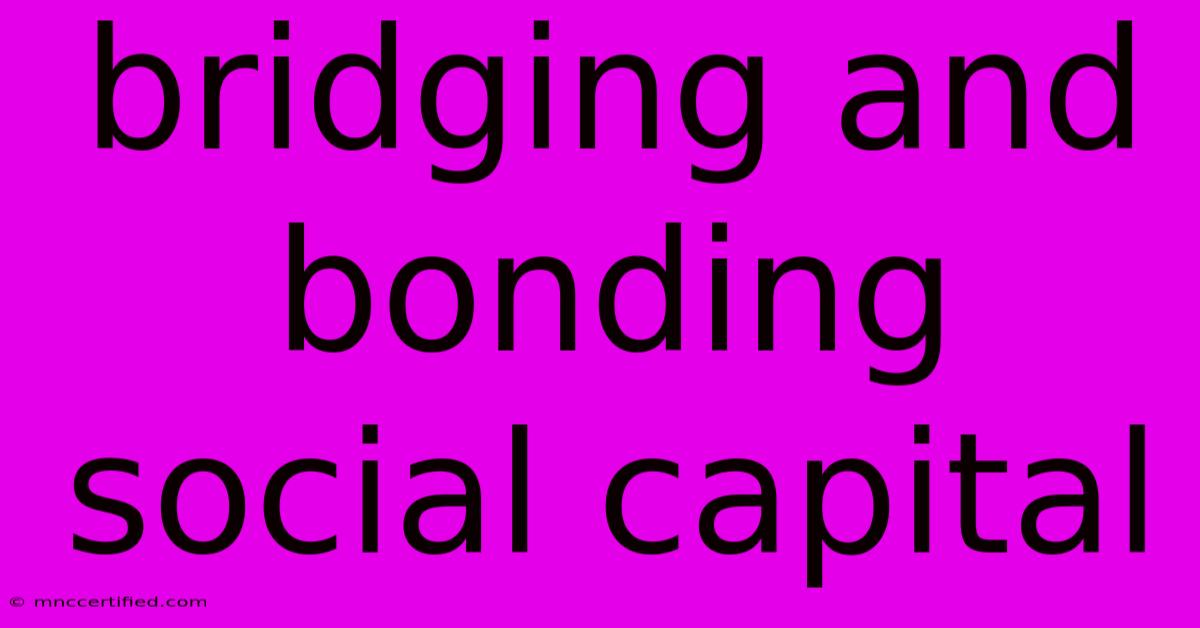Bridging And Bonding Social Capital

Table of Contents
Building Bridges, Strengthening Bonds: The Power of Social Capital
Social capital, often described as the network of relationships and connections within a community, plays a vital role in shaping individuals' lives and fostering societal progress. It's not just about knowing people; it's about the quality of those relationships, the trust, reciprocity, and shared values that underpin them. This article delves into the concept of bridging and bonding social capital, exploring their distinct characteristics and highlighting their crucial role in building stronger communities.
Understanding the Two Types of Social Capital
Bonding social capital refers to the strong ties within homogenous groups, characterized by shared identity, values, and experiences. Think of close-knit families, religious communities, or tight-knit neighborhoods. These connections provide a sense of belonging, support, and mutual trust. While invaluable for individual well-being, bonding social capital can sometimes lead to isolation from other groups, hindering broader social progress.
Bridging social capital, on the other hand, bridges the gap between different groups, connecting individuals across diverse backgrounds and perspectives. It thrives on interactions between people with different ethnicities, religions, socioeconomic statuses, or political affiliations. Bridging social capital facilitates cooperation, promotes understanding, and opens up opportunities for broader collaboration.
The Synergy of Bridging and Bonding Social Capital
While both types of social capital are essential, their combined impact is truly transformative. Imagine a community where strong family bonds (bonding social capital) are complemented by interfaith dialogue groups (bridging social capital). This creates a dynamic ecosystem where individuals feel supported within their own groups while also engaging with those from different backgrounds.
This combined approach fosters:
- Increased social mobility: Bridging social capital helps individuals access information, resources, and opportunities that might not be available within their immediate social circles.
- Reduced social inequality: By fostering understanding and empathy across diverse groups, bridging social capital helps dismantle prejudice and promote social justice.
- Enhanced community resilience: When individuals are connected across different groups, communities become more resilient to challenges, leveraging the collective strengths and knowledge of their diverse members.
Building Bridging and Bonding Social Capital: A Collective Effort
Building and strengthening social capital is a continuous process that requires active participation from individuals, organizations, and communities. Here are some actionable strategies:
For individuals:
- Seek out opportunities to connect with people from different backgrounds. This can be through volunteering, attending community events, or engaging in online forums and social media groups.
- Practice empathy and active listening. This involves making an effort to understand different perspectives and appreciating the richness of diversity.
- Support local initiatives and organizations. By participating in community projects or donating to worthy causes, individuals contribute to building a stronger sense of collective identity and shared purpose.
For organizations:
- Promote inclusive programming and initiatives. Organizations can play a crucial role in creating platforms for diverse individuals to connect and collaborate.
- Support intergroup dialogue and conflict resolution. By fostering open and respectful conversations, organizations can help address misunderstandings and build bridges between different groups.
- Invest in social capital research and development. Organizations can contribute to a better understanding of social capital dynamics and identify strategies for building more inclusive and resilient communities.
For communities:
- Create spaces for social interaction and community building. Public parks, libraries, community centers, and other accessible spaces provide opportunities for individuals to connect and build relationships.
- Encourage cross-cultural exchange programs. These programs can foster understanding, promote empathy, and break down stereotypes between different groups.
- Celebrate diversity and cultural heritage. Acknowledging and appreciating the rich tapestry of cultures within a community strengthens its identity and fosters a sense of belonging for all.
Conclusion: A Foundation for a Thriving Society
Bridging and bonding social capital are not just abstract concepts; they are the bedrock of a thriving society. By fostering strong connections within and across communities, we build a foundation of trust, cooperation, and mutual support that benefits individuals, strengthens communities, and propels societal progress. Let's all strive to build bridges, strengthen bonds, and create a future where everyone feels valued, included, and empowered to contribute to a better world.

Thank you for visiting our website wich cover about Bridging And Bonding Social Capital. We hope the information provided has been useful to you. Feel free to contact us if you have any questions or need further assistance. See you next time and dont miss to bookmark.
Featured Posts
-
Prestige Oro Investment Instructions
Nov 12, 2024
-
Farmers Insurance Settlement Checks
Nov 12, 2024
-
Thank You For Investing In My Future
Nov 12, 2024
-
Business Broker Vs Investment Banker
Nov 12, 2024
-
Tesla Stock Gains 9 As Rally Persists
Nov 12, 2024